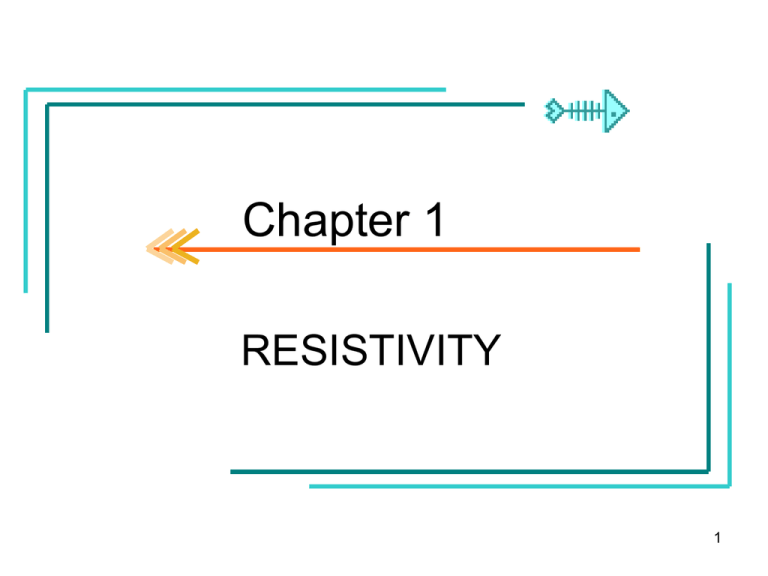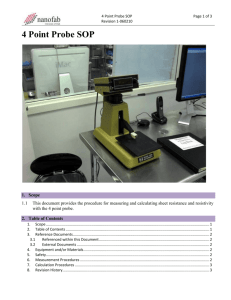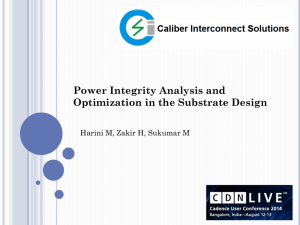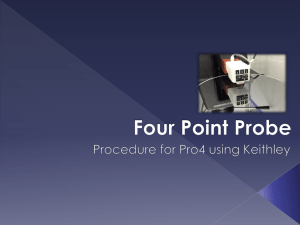Wafer mapping is used to characterize the doping
advertisement

Chapter 1 RESISTIVITY 1 • • • • • • 1.1 1.2 1.3 1.4 1.5 1.6 INTRODUCTION THE FOUR-POINT PROBE WAFER MAPPING RESISTIVITY PROFILING CONTACTLESS METHODS CONDUCRIVITY TYPE 2 1.1 INTRODUCTION 3 • The resistivity in the ingot is not uniform. • The resistivity of epitaxial layers is uniform. • Resistivity affects devices’ series resistance, capacitance, threshold voltage, latch-up behavior, breakdown voltage, hot carrier performance. 4 5 1.2 THE FOUR-POINT PROBE 6 7 8 Two-point arrangement showing the probe resistance Rp , the contact resistance Rc , the spreading resistance Rsp , and the semiconductor resistance Rs 9 10 11 12 Correction Factors F1 corrects for sample thickness F2 corrects for lateral sample dimensions F3 corrects for the distance between probe and sample edges 13 For non-conducting bottom For conducting bottom 14 For t ≦ s/2 For F2 and F3 ≒ 1 Wafer thickness correction factors versus normalized wafer thickness; t is the wafer thickness, s the probe spacing. 15 16 Wafer diameter correction factors versus normalized wafer diameter. For circular wafers D=wafer diameter; for rectangular samples D=sample width. 17 Perpendicular to a non-conducting boundary Parallel to a non-conducting boundary Perpendicular to a conducting boundary 18 Boundary proximity correction factors versus normalized distance d from the boundary. F31 and F32 are for nonconducting boundaries, F33 and F34 are for conducting boundaries. 19 Parallel to a conducting boundary 20 Resistivity of Arbitrarily Shaped Samples Arbitrarily shaped sample with four contacts. 21 Rr R12, 34 R 23, 41 The van der Pauw correction factor F versus Rr. 22 Typical symmetrical circular and square sample geometries. A Greek cross sheet resistance test structure. d≦ L/6 23 A cross-bridge sheet resistance and line-width test structure. 24 Measurement Errors and Precautions 1. Sample size 2. Minority / majority carrier injection 3. Probe spacing For small probe variations, the correction factor is sm=(s1+s2+s3)/3 25 4. Current Recommended four-point probe current versus Si resistivity 26 5. Temperature 6. High resistivity material Temperature coefficient of resistivity versus sample resistivity for 18oC≦T≦28oC for (a) Si, (b) Ge. For p-Si, the curve is valid only for boron-doped Si. 27 7. Surface preparation 28 1.3 WAFER MAPPING 29 Wafer mapping is used to characterize the doping uniformity, especially the ion implantation uniformity 30 (a) (b) Four-point probe contour maps; (a) boron, 1015cm-2, 40keV, ρs(average)=98.5 ohms/square; (b) arsenic, 1015cm-2, 80keV, ρs(average)=98.7ohms/square; 1% intervals. 200 mm diameter Si wafers. 31 1. Double Implant • p(n) type impurity is implanted into n(p) substrate with a dose Φ1 and energy E1. • The desire low dose impurity is implanted with a dose Φ2 and energy E2, no annealing. • Φ2 ~10-2Φ1 and E2 ~ 80%-90% E1. • Measurement is performed right after the implantation. 32 2. Modulated Photoreflectance Schematic diagram of the modulated photoreflectance apparatus 33 Schematic diagram of the modulated photoreflectance apparatus 34 • A pump laser is used to generate thermal wave and cause the volume, thermoelastic, and the optical reflectivity to change. •The laser is modulated at a certain frequency thus establish a periodic temperature variation in the wafer. • A probe laser is used to detect these changes, mainly the reflectivity. • The thermal wave induced changes are proportional to the implanted ions. 1011~1015 cm-2, contactless, non-destructive. Needs calibration 35 (a) (b) Modulated photoreflectance contour maps; (a) boron, 6.5×1012cm-2, 70keV, 648 TW units; (b) boron 5×1012 cm-2, 30keV, 600 TW units; 0.5% intervals. 200mm diameter Si wafers. 36 3. Carrier Illumination To determine junction depth. A focused laser injects excess carriers into semiconductor and forming excess carrier distribution. The carrier density in the substrate is constant. The index of refraction change Δn relates to excess carrier as: q 2 N n 2 K s o m * 2 A steep gradient is occurred at the edge of the doping profile. 37 4. Optical Densitometry UV shined on implant sensitive dye _________________________ Transparent substrate (glass) _________________________ No semiconductor wafer is used. Compare the final to initial (before and after) optical transparency with calibrated results. 1011~1013 cm-2. 38 39 1.4 RESISTIVITY PROFILING 40 Differential Hall Effect For uniformly doped sample. 41 Sample geometry with measurement proceeding from the surface into the sample. 42 Dopant density profiles determined by DHE, spreading resistance profiling, and secondary ion mass spectrometry. 43 Anodic oxidation method is adopted to grow a fixed thickness of oxide layer such that a certain portion of the silicon surface is consumed by etching the grown oxide. This method has a good reproducibility. 44 Spreading Resistance Profiling Spreading resistance bevel block and the beveled sample with probes and the probe path shown by the dashed line. 45 For a cylindrical contact A cylindrical contact of diameter 2r to a semiconductor. The arrows represent the current flow. For a hemispherical contact 46 47 • 80% of the potential drop due to the spreading phenomenon occurs within 5r. • 5g weight is applied. • The bevel angle θ is 1。~ 5。 for junction depth of 1~2μm, and θ < 0. 5。 for junction depth < 0.5μm. • For a step of 5um and an angle of 1o, the equivalent depth resolution is 870 Å. 48 High-resolution spreading resistance and dopant density profiles. 49 1.5 CONTACTLESS METHODS 50 Eddy Current (a) Schematic eddy current experimental arrangement, (b) schematic of the Tencor commercial apparatus showing the eddy current coils and the thickness sound generator. 51 Pa is the absorbed power. VT is the rms rf voltage. n is the coil’s number of turns. σ is the semiconductor conductivity. t is the semiconductor thickness. 52 Since Pa=VT×IT, IT=Pa/VT If VT is fixed, then IT is proportional to ∫σ(x)dx or 1/ρs 53 For the above results to be valid, the sample thickness must be less than the skin depth, such that the current can be uniformly flow through the sample. The skin depth is given by μ0=4π×10-9H/cm. Usually, δ≧5t. 54 Skin depth versus resistivity as a function of frequency. 55 • The phase shift change is detected which is proportional to the distance of the air gap. • Eddy current method is used for uniformly doped wafers. If it is used for highly conductive layer on low conductive substrate, the conductivity ratio must be at least 100 times. 56 57 Wafer thickness and flatness measurement system. 58 1.6 CONDUCRIVITY TYPE 59 CONDUCTIVITY TYPE Identifying flats on silicon wafers. Usually, the primary flat is along the 〈110〉direction. 60 (a) Hot probe, (b) rectifying probe for conductivity type measurements. 61 (C) Equivalent circuit for (b), and (d) experimental data adapted from ref.88. 62 • Majority carriers are diffused away from the hot probe, therefore, the hot probe has positive (negative) potential when the substrate is n (p) type. • An ac signal is applied between probe 1 and 2, the probe 2 has a rectifying contact with the substrate. If V32 has a large positive value and a small negative value, then the substrate is n type. If V32 has a large negative value and a small positive value, then the substrate is p type. 63







